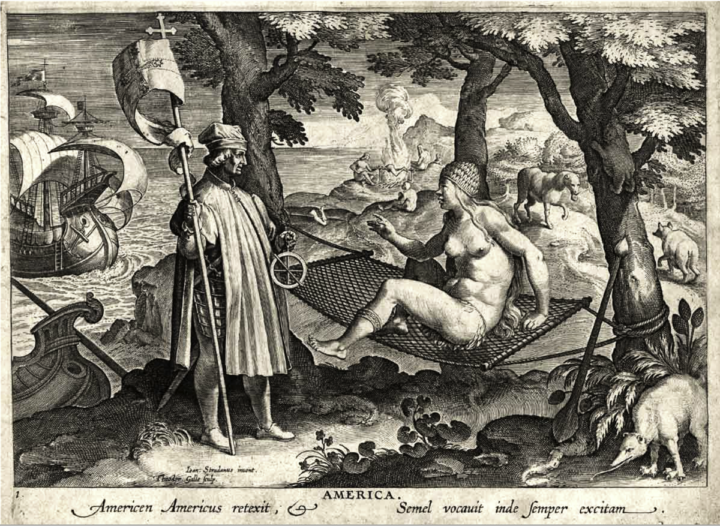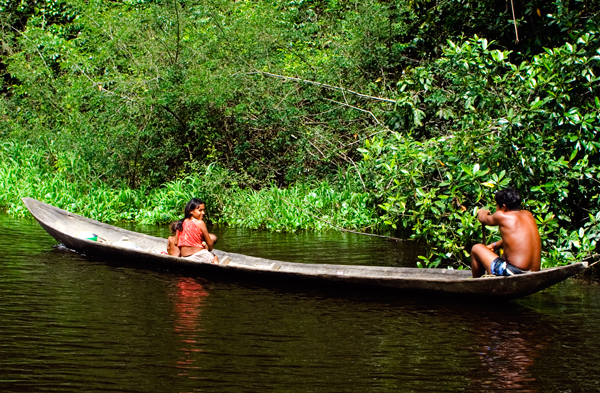By Irene Halford
Guaicaipuro Cuatemoc charges the debt to Europe
By Luis Britto García, El Nacional newspaper, Caracas, 18 October 1990
“Guaicaipuro Cuautemoc, who has come to discover those who are celebrating the discovery. Here am I, a descendant of those who colonised America 40,000 years ago, who has come to discover those who discovered it 500 years ago.
“My European brother at his border asks me for a written document with a visa in order to discover those who discovered me. The European moneylender asks me to pay a debt contracted by Judas which I never authorised to be sold to me. The European pettifogger explains to me that all debts must be paid with interest, even if it means selling human beings and whole countries without their consent. I am gradually discovering them.
“I also have payments to claim. I can also claim interest. The evidence is in the Archivo de Indias (Archive of Indias). Paper after paper, receipt after receipt, signature after signature show that between 1503 and 1660 alone, 185,000 kilos of gold and 16 million kilos of silver were shipped into Sanlucar de Barrameda from America.
“Plunder? I wouldn’t say so. Because that would mean that our Christian brothers are violating their seventh commandment. Pillage? May Tanatzin have mercy on me for thinking that the Europeans, like Cain, kill and then deny their brother’s blood! Genocide? That would mean giving credit to slanderers like Bartolome de las Casa who equated the discovery of the Indies with its destruction, or to extremists such as Dr Arturo Pietri, who states that the outburst of capitalism and of the current European civilisation was due to the flood of precious metals! No way!
“Those 185,000 kilos of gold and 16 million kilos of silver must be considered as the first of several friendly loans granted by America for Europe’s development. The contrary would presuppose war crimes, which would mean not only demanding immediate return, but also compensation for damages.
“I prefer to believe in the least offensive hypothesis. Such fabulous capital exports were nothing short of the beginning of a Marshalltezuma Plan to guarantee the reconstruction of a barbarian Europe, ruined by deplorable wars against the Muslim foe. For this reason, as we approach the Fifth Centennial of the Loan, we must ask ourselves:
“What have our European brothers done in a rational, responsible or at least productive way with the resources so generously advanced by the International Indoamerican Fund? The answer is: unfortunately nothing. Strategically, they squandered it on battles such as Lepanto, invincible armies, Third Reichs and other forms of mutual extermination, only to end up being occupied by the Yankee troops of NATO, like Panama (but without a canal).
Financially, they were incapable – even after a moratorium of 500 years – of either paying back capital with interest or of becoming independent from net returns, raw material and cheap energy that they import from the Third World.
“This disgusting picture corroborates Milton Friedman’s assertion that a subsidised economy can never function properly, and compels us to claim – for their own good – the repayment of capital and interest which we have so generously delayed all these centuries.
“Stating this, we want to make clear that we will refrain from charging our European brothers the despicable and blood-thirsty floating rates of 20 or even 30% that they charge to Third World countries. We shall only demand the devolution of all precious metals advanced, plus a modest fixed annum accumulated over 300 years.
“On this basis, and applying the European formula of compound interest, we inform our discoverers that they only owe us, as a first payment against the debt, a mass of 185,000 kilos of gold and 16 million kilos of silver, both raised to the power of 300. This equals a figure that would need over 300 digits to put it down on paper and whose weight fully exceeds that of the planet Earth.
“What huge piles of gold and silver! How much would they weigh when calculated in blood? To say that in half a millennium Europe has not been able to produce sufficient wealth to pay back this modest interest is as much as admitting to the total financial failure of capitalism.
“The pessimists of the Old World state that their civilisation is already so bankrupt that they cannot fulfil their financial or moral commitments. If this is the case, we shall be happy if they pay us with the bullet that killed the poet. But that is not possible, because that bullet is the very heart of Europe.”

“Allegory of America” engraving by Jan Galle after Jan van der Straet. The scene depicts Amerigo Vespucci representing the Old World explorers as he wakes up a Native American from her hammock slumber. Local flora and fauna dot the background, as well as natives having a cannibalistic roast. Johannes Stradanus or van der Straat, (1523-1605)
All that is stated by the Venezuelan lawyer and historian Luis Britto so eloquently in his fictitious scenario would undeniably still make a very appropriate speech today if presented to the European Union, thus, Latin America must not succumb to the victim role. Sadly, if Las Casas was to walk with us today he would find that from one end to the other, The Latinos’ America is still riddled with contradiction when it comes to the theory and practice of Indigenous Rights despite the departure of the colonisers over two centuries ago. Not only are these communities still suffering due to the actions of ordinary people but also due to the actions of the very same state that signed up to protect them. After all, they did agree to do so back in 1948 when they signed up to the United Nations Human Rights Declaration. And this was reinforced in a more specific way when they signed up to the United Nations Declaration on the Rights of Indigenous Peoples (UNDRIP) that was adopted by the General Assembly on Thursday, 13 September 200. Even in the land that sells itself as the Indigenous Rights heaven, the local tribes in Venezuela have found themselves denied many rights. A recent example of this was the denial of the right to travel and to exercise their right to freedom of expression when wanting to participate in the recent national demonstration against the current government via ‘La Toma de Caracas’. The governor of the Amazon State informed that about 2000 left their homes: 700 km away from the capital, in order to exercise their constitutional right to gather – yet only just over a hundred managed to make it due to the devious tactics used by the security forces throughout the national territory trying to prevent the movement of people wanting to reach Caracas to make a stand against the hunger, insecurity and the environmental degradation that their communities are currently enduring.
Inconsistent with the still dominant poverty despite numerous promises, the government of the day has spent an alarming level of GDP in arming the country. There has been an increase of military expenditure of up to 70%, according to the Stockholm International Peace Research Institute (SIPRI), during the current administration whilst the oil revenues permitted to do so. All in order to supposedly protect it from the invasion of the culprit of all wrong doings in the Americas: the dreaded gringos. You cannot help to ask if this was just another ludicrously over-financed ‘investment ‘or a fine example of state security ineptitude on behalf of the government when unable to even protect a far smaller area than the national territory from a far smaller army. This isolated and consequently vulnerable territory is the home to numerous indigenous communities that have been left to fend for themselves their fragile livelihood – yet not from the yanks or their subordinates Pitiyankees armies but – of other types of foreign armies: that of miners determined to carry out the exploitation of natural resources in the most irresponsible way causing irreversible damage to a site that is so unique in its biodiversity that it even comes under the UNESCO World Heritage umbrella since 1994. Independent of its UNESCO status, the National Park of Canaima has since its establishment in 1962 benefited, until very recent, from a carefully guarded and protective policy that helped maintain its fragile ecosystem – independent of the government of the day. Lately, it is beyond recognition not only due to the circumstances already mentioned but due to the, without precedent, an attitude of total disregard by the very same state that agreed to uphold the laws that protect this national and international natural heritage. The lack of action raises some serious questions about negligence versus the supposed commitment to indigenous communities and also about the government’s green credential. All and all a considerable step back has taken place when it comes to both human and environmental rights in such a previously paradisiacal setting. In conclusion, the Dia de la Raza or of Resistance has not much to celebrate 500 years or so in the Americas as the current state of affairs shows. However, we must remember that it is the indigenous communities that are the main keepers of our earth – so if not for their sake, at least for the sake of humankind, let us help them, in order to assist via proxy their endeavour of looking after our very fragile planet.
Notes
UN Declaration on the Rights of Indigenous Peoples
http://www.un.org/esa/socdev/unpfii/documents/DRIPS_en.pdf
Article 29
1.
Indigenous peoples have the right to the conservation and protection of the environment and the productive capacity of their lands or territories and resources. States shall establish and implement assistance programmes for indigenous peoples for such conservation and protection, without discrimination.
2.
States shall take effective measures to ensure that no storage or disposal of hazardous materials shall take place in the lands or territories of indigenous peoples without their free, prior and informed consent.
3.
States shall also take effective measures to ensure, as needed, that programmes for monitoring, maintaining and restoring the health of indigenous peoples, as developed and implemented by the peoples affected by such materials, are duly implemented.










